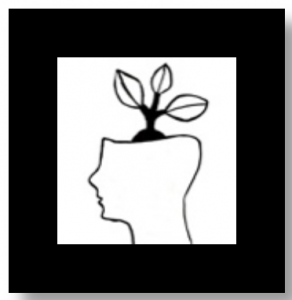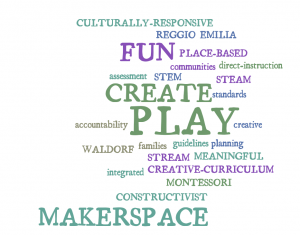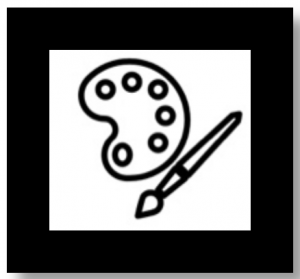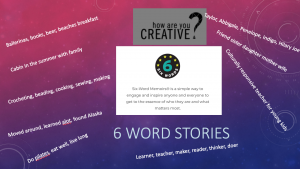Creativity is putting your imagination to work, and it’s produced the most extraordinary results in human culture.
Sir Ken Robinson
Superpower Story #2 – The Antler
Teacher Matt is sitting on the floor with 18 four and five-year-old children sitting around him. All the children have their eyes on Matt as he holds up an object. He tells the children that he found something in the woods the other day when he was taking a hike in the woods behind the school and he was wondering what they should do with it. He then asks the children to tell him what they see.
Matt has a large piece of paper hanging on an easel that is next to him and begins to write different words that he hears. One child shouts, “I know, I know”, Matt asks him to keep it to himself right now because right now we are just going to describe things about it. Children add different descriptors such as it’s brown, its rough, it’s skinny, it’s tall, it has some dry moss on it. These continue.
Then Matt asks what could we do with it? Children start coming up with different uses such as scratch your head, hang it on the wall to put a coat on it, you could build with it and make it be a road for cars, Matt draws some of the ideas in quick drawings
Finally, teacher Matt asks, “Who knows what it is?” Show me with a hand on your head (instead of raising a hand). Every child puts her or his hand on their head. Matt calls on one student and they say, “it’s a caribou antler, we got one on our wall at home.” After this comment, several other children begin telling stories about antlers, their families going hunting, and eating caribou.
Superpower Reflection Questions
- How did the teacher support critical thinking in the classroom by asking about the object?
- How did the teacher support creativity in each child?
- How did the teacher support collaboration and community building?
- How could the teacher communicate and promote ways to make the learning visible?
- How did the teacher encourage each child’s superpower?
After a short sharing time about experiences related to the antler and antler, moose, deer stories, Teacher Matt redirected the class to put their hands on their heads like they are antlers. The children giggled – Matt just sat and waited for all the children to be calm. Once they were all looking (with arm antlers), he asked the children to turn to someone next to them and share their story for one minute (Teacher Matt set a timer with the children all watching).
Later, the children were excused to their tables and asked to draw a picture or write/tell a story about an antler.
After reading about the Antler Superpower Story, with a partner think about the reflection questions.
- How can teachers help children a sense of community in the classroom, so they can feel confident in their learning?
- How does culture, sense of place, and student’s prior knowledge and experience guide the curriculum and connect to the standards?
Seeing Strengths
When we learn to see and build on the strengths of our children, we can find each of our superpowers. Using creativity and imagination and building on real things in our environment and place, we all will feel connected and empowered.
This chapter explores how we teach and promote children’s superpowers – particularly that of creativity. We take a deep dive and explore where our curriculum comes from, how we facilitate different curriculum models and different practices that promote 21st Century skills in the classroom. We look at the role of culture, local context, and new ways of thinking to support creativity as a superpower.
 Think about it! – Critical Thinking and Reflection
Think about it! – Critical Thinking and Reflection
Learning to See
Learning to really see what is going on around us, in the classroom, in the community, in cultural/religious values, and even the politics of the community will help the teacher and in turn, the children really connect to their place. Planning a meaningful curriculum takes time and sensitivity to understand what is going on around us. Some classrooms may be microcosms of things going on in the bigger world, with an authentic curriculum that is connected, or we may have a curriculum guided by national norms. Most classrooms have a combination of the two so learning to really see your children, what they can do, what their families and cultures expect will help to show how you value what each has to offer. This shift is building a curriculum, one that meets and guides our children based on both standards and family and community values will help make the teaching and learning experience more meaningful to all involved.
As Deb Curtis and Margie carter state, “Listening, observing, and documenting is a pedagogy”
What is Curriculum?
The curriculum is a word that is thrown around in educational settings, in schools and is in every education book you read. Yet, it is a nebulous word that can mean a broad set of meanings as they relate to schools. So, for purposes of this book and the larger setting of schools and educational settings as they relate to curriculum, we will define curriculum as a framework based on standards, ideas, questions or other relevant items in an educational setting that guides the instructor, the student, and the environment to promote learning. The curriculum will include a set of content, materials, and/or developmental matter that students are expected to learn and accomplish through a variety of experiences. The outcomes of the experiences are tested through an assessment to know if the curriculum worked. Then the great teachers add one more component to their curriculum – their own reflection and connections. They will ask, what did I learn about the experience and what will I do to build on that learning? To better understand these concepts, we must deconstruct the above statements as we will below in the section of Four Parts.
Four Parts
There are four parts to a curriculum:
- Planning – Where does our curriculum come from and What do we want kids to know
- Teaching and Pedagogies – How are we going to facilitate the learning and experiences
- Assessing – How will we know if we were successful
- Reflecting – What should I do next
Planning a Creative Curriculum
When one plans their curriculum, they must think about the four parts list above as the framework. Once they start digging into the specifics, we must be careful to think about our own cultural lens and expectations. Do they match those of the family and community? Do they match the school and state standards and developmental guidelines? Understanding the bigger picture as well as your own biases will make the curriculum creative, culturally responsive and relevant to the communities and families you serve.
Teaching and Pedagogies that Promote Creativity
Early childhood educators have been exploring various ways to incorporate 21st century pedagogies into their classrooms. These pedagogies include a variety of practices including, interdisciplinary curriculum models, developmentally appropriate technologies, place-based curriculum, project-based learning and the Reggio Emilia practices. Two areas that rise to the top and that are part of all of these models are Culturally relevant teaching (sometimes referred to as Culturally Responsive Teaching) and the 21st Century Skills

(4Cs and innovative learning model) (New, 2007; Gandini, 2016; Fickel, MacFarland & MacFarland, 2017; Burke & Grosvener, 2015; Hammond, 2017). Connecting the two strategies and approaches in schools and building on the strengths of the other models above supports young children’s learning. Having an authentic curriculum, one that is meaningful and based on the student’s identity and culture. Using an emergent curriculum or a project appoach that is based on relevant topics can help students connect to their surroundings (Seitz, 2007, Curtis, Lebo, Cividanes, & Carter, 2013; Gandini, 2011).
Critical Thinking and Reflection thoughts
Teaching is a very complex act that includes many facets. Some teachers are better at one part than another.
Which part of teaching seems the easiest to you?
Planning
Teaching
Assessing
Reflecting
If you answered all four then you are ready for the classroom! Most teachers work at each element, in particular, they look at ways to encourage creativity and to connect to the children, their families, their cultures and backgrounds, and the community. Think about the four elements again with the creativity and cultural lens. Does that make it easier or harder to teach? Does your curriculum allow for flexibility to address student needs?
 Play with it! – Creativity and Culturally Relevant
Play with it! – Creativity and Culturally Relevant
Making Challenge (goals and expectations) – Six Word Stories
Think about one’s own definition of creativity and learn about other’s thoughts about creativity. Create a six-word story that exemplifies how you are creative.
Supplies

- Quiet comfortable space
- Notepad and writing implement (for quick notes)
- Paper or google slides/powerpoint
- something to write/type with
Process
- Brainstorm how you are creative – make a list of as many things you do, you think about, things you like. You could turn these into a wordcloud to see what stands out.
- Select 6 words that tell a story and write these down. See above for some examples:
- Write some stories. It may be a group of words that go together, it may tell a thought or story. Include one of “how are you creative?”
Go to the How are You Creative Website to enter your superpower into the Alaska Database.
Integrated Curriculum Areas
- Literacy
- Media arts
- Visual arts
Extensions
- Draw a self-portrait to go with the 6-word story
- Create a small group mural or collage that has items that represent each person in the group
- Create a 6-picture story
- Act-out or dramatize the six creativity characteristics and have the other group members guess what you are doing
Creativity and Cultural Relevance Thoughts and Questions
- Why is this experience valuable?
- Having time to reflect about oneself, listen to others, then produce something tangible can help build some confidence in one’s abilities. Did you see similarities in any of the characteristics? Did you find differences?
- Do you feel like you know more about your partner and the other partners you worked with? Did you strengthen your relationship?
- How did your prior experiences shape your own sense of creativity?
- How did your cultural backgrounds shape your sense of creativity?
